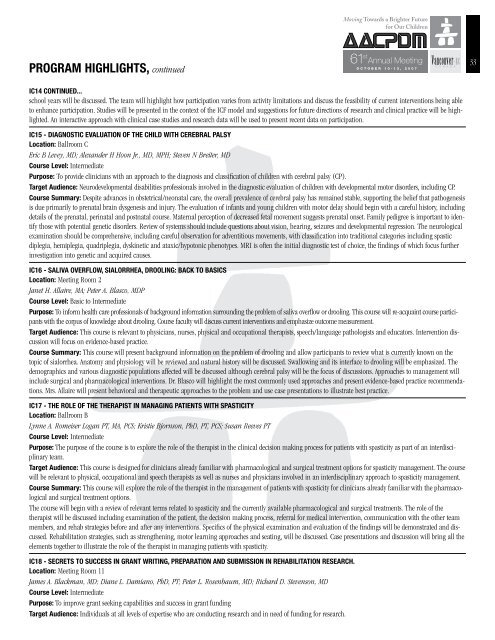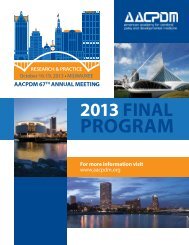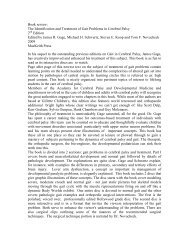Final Program - American Academy for Cerebral Palsy and ...
Final Program - American Academy for Cerebral Palsy and ...
Final Program - American Academy for Cerebral Palsy and ...
You also want an ePaper? Increase the reach of your titles
YUMPU automatically turns print PDFs into web optimized ePapers that Google loves.
<strong>Program</strong> HigHligHTs, continued<br />
iC14 ConTinued...<br />
school years will be discussed . The team will highlight how participation varies from activity limitations <strong>and</strong> discuss the feasibility of current interventions being able<br />
to enhance participation . Studies will be presented in the context of the ICF model <strong>and</strong> suggestions <strong>for</strong> future directions of research <strong>and</strong> clinical practice will be highlighted<br />
. An interactive approach with clinical case studies <strong>and</strong> research data will be used to present recent data on participation .<br />
iC15 - diagnosTiC evaluaTion of THe CHild WiTH <strong>Cerebral</strong> <strong>Palsy</strong><br />
location: Ballroom C<br />
Eric B Levey, MD; Alex<strong>and</strong>er H Hoon Jr., MD, MPH; Steven N Breiter, MD<br />
Course level: Intermediate<br />
Purpose: To provide clinicians with an approach to the diagnosis <strong>and</strong> classification of children with cerebral palsy (CP) .<br />
Target audience: Neurodevelopmental disabilities professionals involved in the diagnostic evaluation of children with developmental motor disorders, including CP .<br />
Course summary: Despite advances in obstetrical/neonatal care, the overall prevalence of cerebral palsy has remained stable, supporting the belief that pathogenesis<br />
is due primarily to prenatal brain dysgenesis <strong>and</strong> injury . The evaluation of infants <strong>and</strong> young children with motor delay should begin with a careful history, including<br />
details of the prenatal, perinatal <strong>and</strong> postnatal course . Maternal perception of decreased fetal movement suggests prenatal onset . Family pedigree is important to identify<br />
those with potential genetic disorders . Review of systems should include questions about vision, hearing, seizures <strong>and</strong> developmental regression . The neurological<br />
examination should be comprehensive, including careful observation <strong>for</strong> adventitious movements, with classification into traditional categories including spastic<br />
diplegia, hemiplegia, quadriplegia, dyskinetic <strong>and</strong> ataxic/hypotonic phenotypes . MRI is often the initial diagnostic test of choice, the findings of which focus further<br />
investigation into genetic <strong>and</strong> acquired causes .<br />
iC16 - saliva overfloW, sialorrHea, drooling: baCk To basiCs<br />
location: Meeting Room 2<br />
Janet H. Allaire, MA; Peter A. Blasco, MDP<br />
Course level: Basic to Intermediate<br />
Purpose: To in<strong>for</strong>m health care professionals of background in<strong>for</strong>mation surrounding the problem of saliva overflow or drooling . This course will re-acquaint course participants<br />
with the corpus of knowledge about drooling . Course faculty will discuss current interventions <strong>and</strong> emphasize outcome measurement .<br />
Target audience: This course is relevant to physicians, nurses, physical <strong>and</strong> occupational therapists, speech/language pathologists <strong>and</strong> educators . Intervention discussion<br />
will focus on evidence-based practice .<br />
Course summary: This course will present background in<strong>for</strong>mation on the problem of drooling <strong>and</strong> allow participants to review what is currently known on the<br />
topic of sialorrhea . Anatomy <strong>and</strong> physiology will be reviewed <strong>and</strong> natural history will be discussed . Swallowing <strong>and</strong> its interface to drooling will be emphasized . The<br />
demographics <strong>and</strong> various diagnostic populations affected will be discussed although cerebral palsy will be the focus of discussions . Approaches to management will<br />
include surgical <strong>and</strong> pharmacological interventions . Dr . Blasco will highlight the most commonly used approaches <strong>and</strong> present evidence-based practice recommendations<br />
. Mrs . Allaire will present behavioral <strong>and</strong> therapeutic approaches to the problem <strong>and</strong> use case presentations to illustrate best practice .<br />
iC17 - THe role of THe THeraPisT in managing PaTienTs WiTH sPasTiCiTy<br />
location: Ballroom B<br />
Lynne A. Romeiser Logan PT, MA, PCS; Kristie Bjornson, PhD, PT, PCS; Susan Reeves PT<br />
Course level: Intermediate<br />
Purpose: The purpose of the course is to explore the role of the therapist in the clinical decision making process <strong>for</strong> patients with spasticity as part of an interdisciplinary<br />
team .<br />
Target audience: This course is designed <strong>for</strong> clinicians already familiar with pharmacological <strong>and</strong> surgical treatment options <strong>for</strong> spasticity management . The course<br />
will be relevant to physical, occupational <strong>and</strong> speech therapists as well as nurses <strong>and</strong> physicians involved in an interdisciplinary approach to spasticity management .<br />
Course summary: This course will explore the role of the therapist in the management of patients with spasticity <strong>for</strong> clinicians already familiar with the pharmacological<br />
<strong>and</strong> surgical treatment options .<br />
The course will begin with a review of relevant terms related to spasticity <strong>and</strong> the currently available pharmacological <strong>and</strong> surgical treatments . The role of the<br />
therapist will be discussed including examination of the patient, the decision making process, referral <strong>for</strong> medical intervention, communication with the other team<br />
members, <strong>and</strong> rehab strategies be<strong>for</strong>e <strong>and</strong> after any interventions . Specifics of the physical examination <strong>and</strong> evaluation of the findings will be demonstrated <strong>and</strong> discussed<br />
. Rehabilitation strategies, such as strengthening, motor learning approaches <strong>and</strong> seating, will be discussed . Case presentations <strong>and</strong> discussion will bring all the<br />
elements together to illustrate the role of the therapist in managing patients with spasticity .<br />
iC18 - seCreTs To suCCess in granT WriTing, PreParaTion <strong>and</strong> submission in reHabiliTaTion researCH.<br />
location: Meeting Room<br />
James A. Blackman, MD; Diane L. Damiano, PhD, PT; Peter L. Rosenbaum, MD; Richard D. Stevenson, MD<br />
Course level: Intermediate<br />
Purpose: To improve grant seeking capabilities <strong>and</strong> success in grant funding<br />
Target audience: Individuals at all levels of expertise who are conducting research <strong>and</strong> in need of funding <strong>for</strong> research .<br />
33







